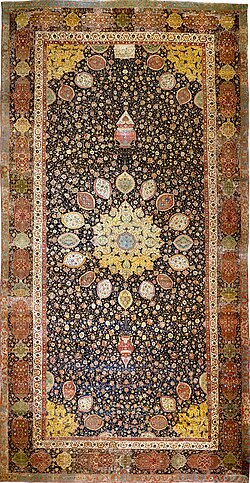Ardabil Carpet
| Ardabil Carpet | |
|---|---|
 | |
| General information | |
| Name | Ardabil Carpet |
| Original name | فرش اردبیل |
| Alternative name(s) | Shaykh Safi Carpet |
| Origin | Iran |
| Date | 1539-1540 |
| Period | Safavid |
| Artist/Maker | Maqsud Kashani |
| Name Museum | Victoria Albert Museum |
| Acquire Date | March 1893 |
| Gallery location | Islamic Middle East, Room 42, The Jameel Gallery, case 21 |
| Technical information | |
| Common designs | Medallion with 16 satellite ovals, Lamps |
| Common motifs & patterns | Blossom, Rosettes, Floral Meander |
| Dimensions | 529.5×1032.5 |
| Common colors | Dark Red, Red, Light Red, Yellow, Green, Dark Blue, Blue, Light Blue, Black, White |
| Dyeing method | Natural |
| Foundation material | Silk |
| Knot type | Asymmetrical (Persian) |
| Knot density | 5300 Knots per sq. dm (340 per sq. in) |
The Ardabil carpet is one of the largest Islamic carpets in existence. It is also of great historical importance. It was commissioned as one of a pair by the ruler of Iran, Shah Tahmasp, for the shrine of his ancestor, Shaykh Safi al-Din, in the town of Ardabil in north-west Iran.
In a small panel at one end, the date of completion is given as the year 946 in the Muslim calendar, equivalent to 1539-40. The text includes the name of the man in charge of its production, Maqsud Kashani.
The carpet is remarkable for the beauty of its design and execution. It has a white silk warp and weft and the pile is knotted in wool in ten colours. The single huge composition that covers most of its surface is clearly defined against the dark-blue ground, and the details of the ornament - the complex blossoms and delicate tendrils - are rendered with great precision.
History
Materials
Foundation and Pile
Techniques and structures
Color and dyeing
Motifs and patterns
Weaving techniques
Marks and inscriptions
Gallery
- Ardabil Carpet-Victoria Albert Museum.jpg
Ardabil Carpet (1539-1540), Albert Museum
- Ardabil Carpet-Lacma Museum.jpg
Ardabil Carpet (1539-1540), Victoria Lacma Museum